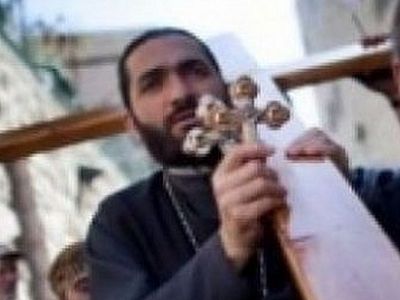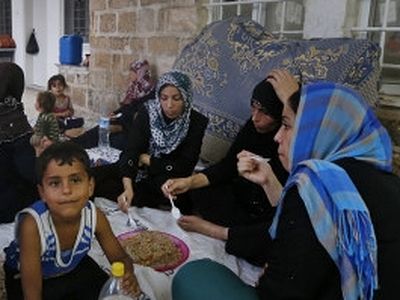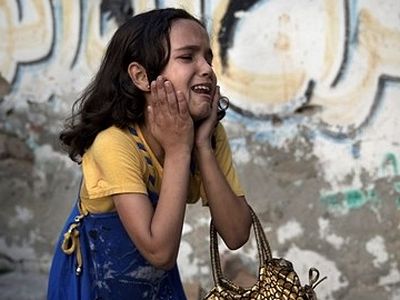Source: independent.co.uk
The Sunday service had been taking place in a morning of quietness and calm, a rare chance of reflection amid the turbulence of war. That ended as the last prayers were being held, the sound of air strikes and tank rounds echoing not far from the church: the ‘humanitarian ceasefire’ was over.
It was one interlude on 24 hours of truce and counter-truce. A six hour window agreed on Saturday by Israel and Hamas; the Israeli government extending it to 12; Hamas rejecting it, fighting starting again; the Israelis offering a 24 hour ceasefire, only to cancel it; Hamas then offering their own 24 hours ceasefire; Israeli prime minister Benjamin Netanyahu charging that Hamas had breached its own ceasefire.
Amid all this two things were clear to the refugees who had taken refuge at St Porphyrios: they were not going to go back to their homes they had been forced to abandon, and they were not going to move to the mosque down the road. Both, they felt, would be highly dangerous.
Around 2,000 people, the vast majority of them women and children, including infants, had gathered at the Greek Orthodox church in Zaytun, and although caring for them was meant to be shared with the Katib Weleyat, most, all of them men, went to the mosque to pray and to use the washing facilities. Families sleep on mattresses in the corridors and rooms of the church and adjoining buildings, meals are provided, and doctors from a nearby private hospital have been providing medical care.
The midnight prayers for the last Friday of Ramadan, the holy month of fasting, were held at the courtyard of St Porphyrios. “It would have been simply too risky going there, they might have bombed the mosque,” Sajal Abu-Hamsha wanted to explain, sitting this afternoon at the same courtyard. “We certainly would not go and live there, the Israelis have bombed so many mosques already”. Around a dozen gathered around murmured agreement.
Sajal and her husband Fadil cannot take their family of 10 back to their home at the town of Beit Hanoun. They returned during the ceasefire on Saturday to find it had been pulverised. “There was nothing left, we did not have much time when we had to leave out home, there were things we wanted to collect, but everything had been destroyed. We came back here quickly, we feel we are safe here.”
St Porphyrios has been hit by tank shells, blowing up water tanks, damaging a neighbouring house belonging to the church, as well as some tombs in the adjoining graveyard. “That was last Monday and we haven’t been hit since. The Israelis know where we are and I can only hope what happened last week was a mistake, we have had things nearby, but no more damage so far” said Alexios, the Archbishop of Tiberias and Gaza, after holding the morning service.
The congregation had been no more than 20, compared to around 250 before the conflict. “People are scared, they don’t want to leave their home, petrol for the car is a problem”, pointed out the Archbishop. Later in afternoon, the body of a Christian woman was found buried under debris nearby. The total death toll for Palestinians stands at 1060, according to health officials in Gaza. Forty-three Israeli soldiers have been killed.
St Porphyrios dates back to 407 AD. It was converted to a mosque in the 7 Century and a new church built in the 12 Century. “This has been a place of God for a long time and if people seek sanctuary it is our duty to provide it. But we cannot take any more, there are around 600 people in the church itself, 430 of them are children, 117 of them are babies aged 20, 30 days. So the fact is”, said the Archbishop, “we can’t take any more, we would not be able cope.
“I know people feel safer here than a mosque. I know a number of mosques had been bombed; why the Israelis do it? Who knows?”
The Israeli military insists that Muslim holy place had been hit because they were being used by militants. After missile strikes reduced al-Farouq mosque, near the Nuseirat refugee camp to rubble, leaving just the minaret standing, it issued aerial photos which showed, it stated, that rockets were being stored there.
No explanations, however, have been given for other attacks. Ten minutes’ drive from the church, the dome of the Al-Shamaa mosque was pitted with holes, the windows had been in blown in. The building next door, attached to the mosque and used for ablutions before prayers, was the main target. “But they fired at the mosque as well”, maintained Ahmad Huddad, the caretaker. “So you see, not even a place of worship is safe now.”
That was the definite view of the al-Adawi, an extended family of 30 who arrived outside St Porphyrios. They had left their home between Zaytun and Shujayia following fierce bombardment, returning during the truce on Saturday. But that got cancelled, shelling began, and they left again.
They had tried UN shelters, unused schools, to find they were full. Now they have been told there was no room at the church either.
The al-Adawis were experiencing the social strains on an already fractured society which have come with more than 100,000 people on the move. “We were staying with my brother-in-law for a while, but he became unhappy with having so many people in the house, that is the reason we went back to our home” explained Mohammed al-Adawi. “But it got really dangerous this morning, so we left. We had put all our hoped on this church, all we need is somewhere to sleep.”
Two men joined the conversation. “We can’t have 100 people coming here every day from other areas” declared Ahmed Shabaan. “Everyone is under pressure here, they should stay in their own areas, or they should keep going, maybe to Gaza City. This area cannot take any more.” His companion offered them a temporary place at the mosque. “You will be alright there” he assured, before admitting that he was not staying there himself.
The family were adamant they were not going to go down that path. “I got this at a mosque” claimed Safwan al-Adawi, pointing to a cut on his head, “and I had just gone there to pray”. Mr Shabaan, who was keen stress that he was an American citizen, had served briefly in the US army, and had broad experience of life, was dismissive: “That is the problem here, it’s the culture, people think others should look after them.”




